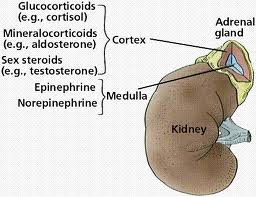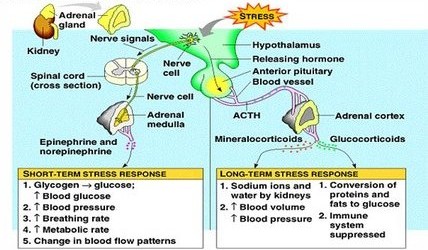
Stress! Stress takes place in a human being in many forms, for example- recovering from an injury, losing a friendly video game match, missing out the first scene of your favourite movie, failing in an examination, running away from an invading enemy, appearing for an examination, work pressure, peer pressure, too little or too much exercise, fear, lack of relaxation, lack of sleep, negative attitudes, mild starvation, and for females, stress is also related with shopping. So, Adrenal Glands is the first thing that should come to your mind when you are stressed. Adrenal Glands were first described in the year 1563.
The Adrenal Glands also referred to as suprarenal glands are endocrine glands that are situated at the top of the kidneys in humans.
The right Adrenal Gland is triangular in shape, whereas the left Adrenal Gland is semi-lunar shaped. The Adrenal Glands vary significantly in size, nerve supply and shape in other animal species. The cells of the two parts are interspersed to varying degrees in some of the vertebrates. In an adult human, the Adrenal Gland ranges from 70 grams to 10 grams.
The Adrenal Glands consist of the Adrenal Cortex and Adrenal Medulla. They are mainly responsible for releasing hormones in response to the stress and the regulation of fluid volume. The main purpose of the Adrenal Gland is to respond to stress. Each gland is basically divided into an inner medulla and outer cortex. Different hormones are secreted by both medulla and cortex.
The adrenal cortex basically produces corticosteroid and androgen hormones. Some specific cortical cells are responsible for producing hormones that include cortisol, aldosterone and androgens like androstenedione. The Adrenal cortex comprises three zones or layers in the adult gland. The outer region is called Zona glomerulosa, which is responsible for producing mineralocorticoids. The mineralocorticoids influence the metabolism of sodium and potassium. Aldosterone is the most important mineralocorticoid that is secreted in response to increased level of potassium or decreased blood flow to the kidneys. Potassium, water and sodium are conserved by the Aldosterone. The inner region is called the Zona reticularis. It secretes glucocorticoids, which regulates metabolism of protein, carbohydrates and fat. Cortisol is the most important glucocorticoid, which enhances the metabolism rate by breakdown of fats and helps in production of glucose. They also produce small amounts of androgens, basically the male sex hormones. They help in developing secondary-sex characteristics and are thought to aid growth during childhood. The Zona Fasciculata is situated between the glomerulosa and reticularis. It has the same function as that of reticularis, and is usually activated only when the innermost region needs backup. The three zones of the adrenal cortex comprise about 20 percent of the fetal glands size, whereas the fetal cortex comprises 80 percent of the glands size during fetal life.

The adrenal medulla is surrounded by the adrenal cortex and it is also the core of the Adrenal Gland. The Medulla secretes about 20 percent norepinephrine (noradrenaline) and about 80 percent epinephrine (adrenaline) in the bloodstream.
The effects of norepinephrine and epinephrine when released into the body include increased heart rate, increase in blood sugar level, increase in metabolic rate, dilation of the pupils which improves the sight in low lighting conditions, dilation of bronchioles to increase oxygen intake in the body and constriction of the blood vessels to increase blood pressure

The diseases of the Adrenal Glands are divided into those of cortex and those of the medulla. Pheochromocytoma is the only known disease of the adrenal medulla, which is basically a tumour. Excessive quantities of epinephrine and norepinephrine are secreted which leads to hypertension, headaches, anxiety and sweating. Addison is the disease of the adrenal cortex which basically may be hyper function (that is basically due to excessive secretion of adrenocortical hormones) or hypofunction (that is due to insufficient secretion of these hormones). Waterhouse-Friderichsen is a disease caused due to bleeding into the Adrenal Glands, which is usually caused due to bacterial infection. Congenital adrenal hyperplasia is basically genetic effect of enzymes that are involved in cortisol production, which usually affects the sex characteristics of the patient. Excessive production of cortisol leads to Cushing’s syndrome and it is usually characterised by high blood pressure, diabetes, muscle weakness, depression, obesity, rounding and reddening of the face and in women it is characterised by cessation of menstrual cycle.



